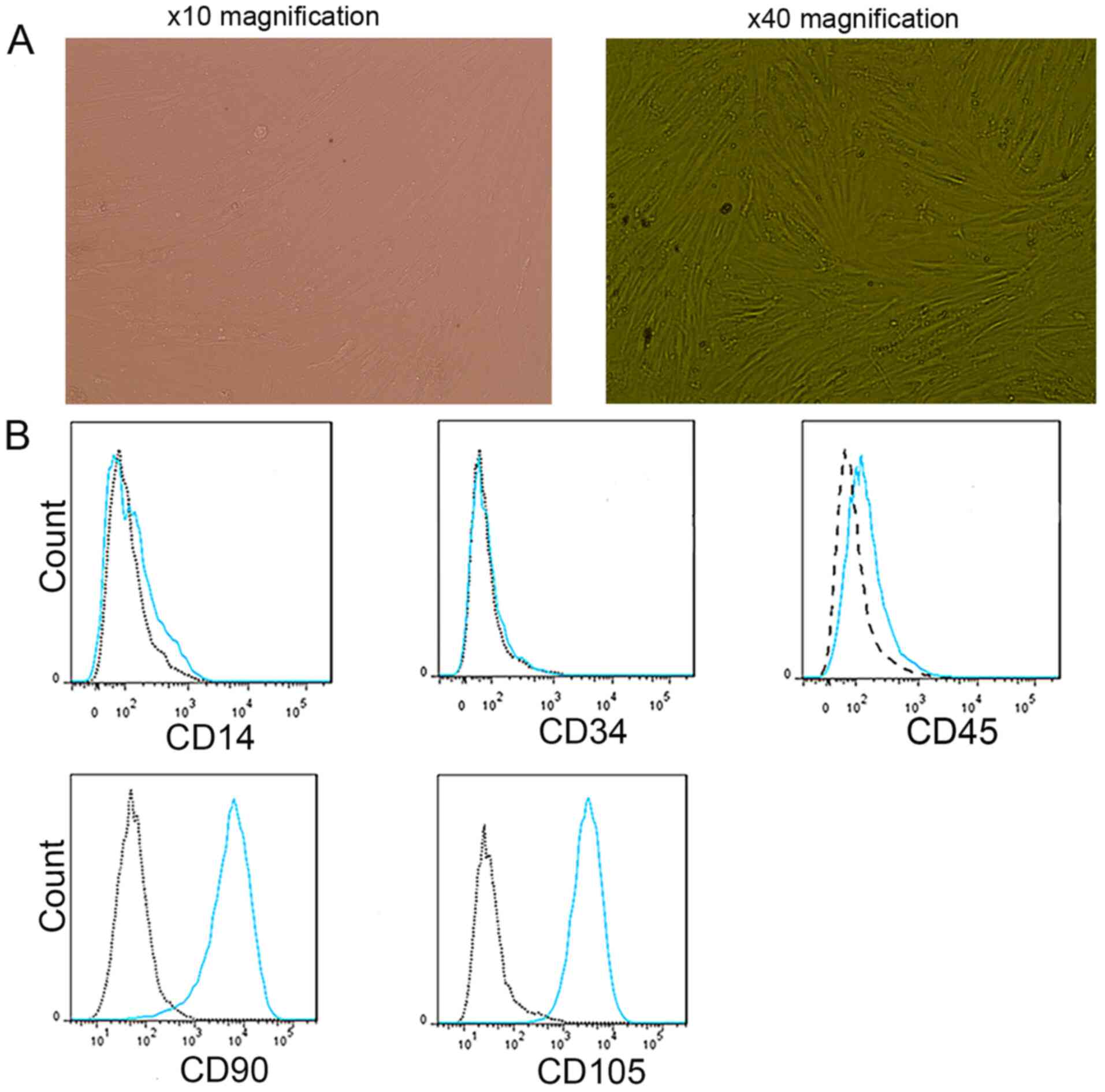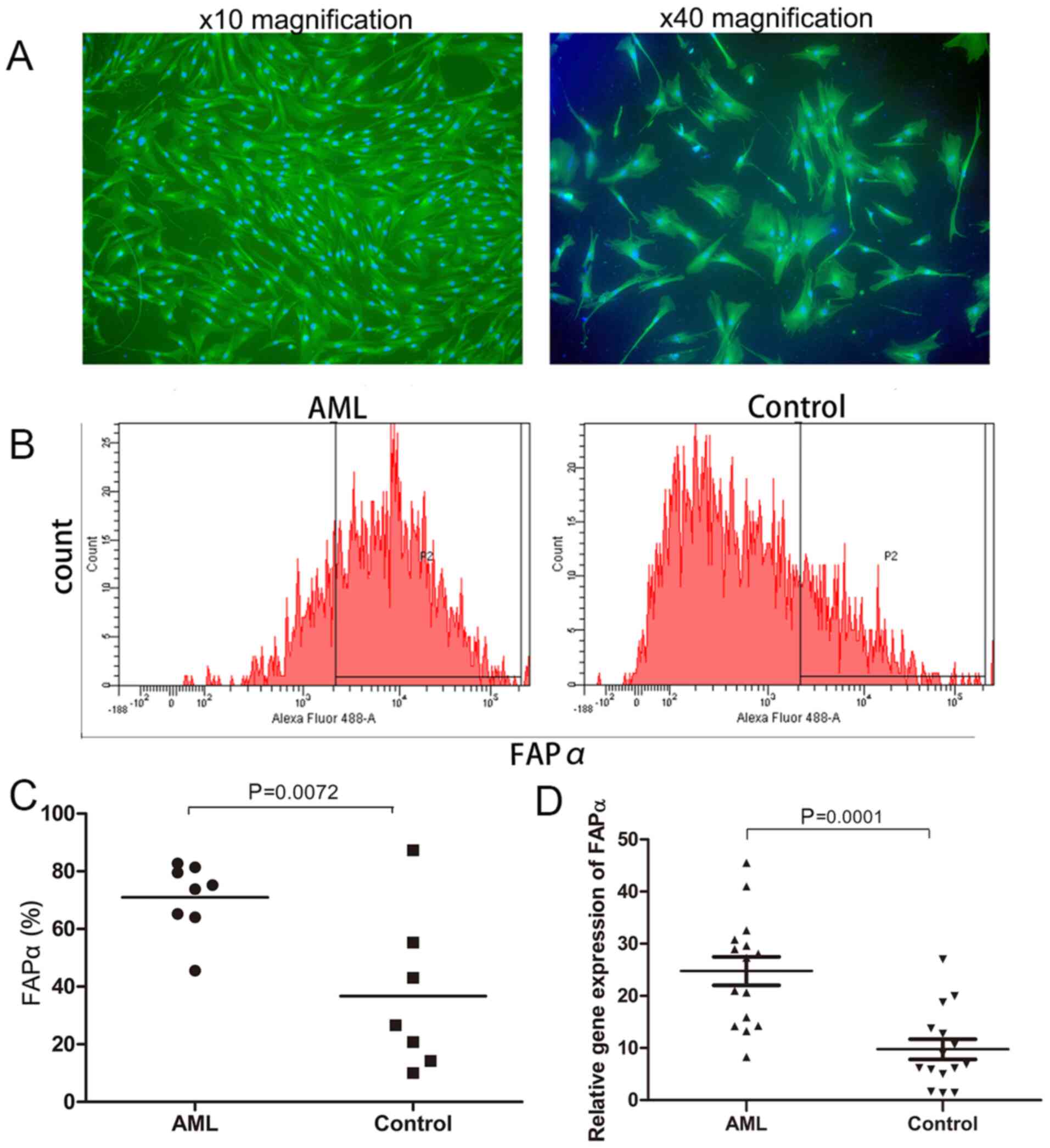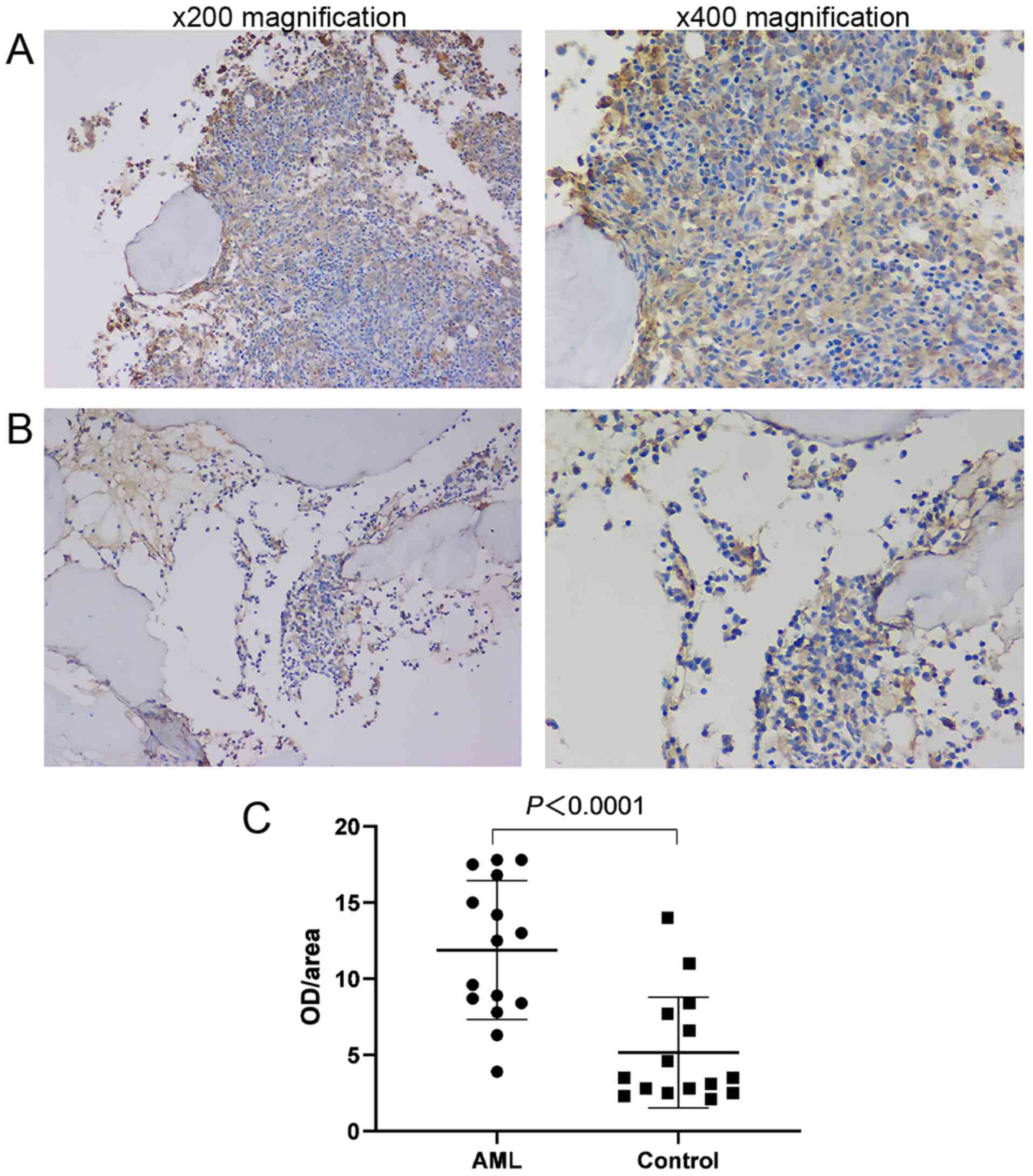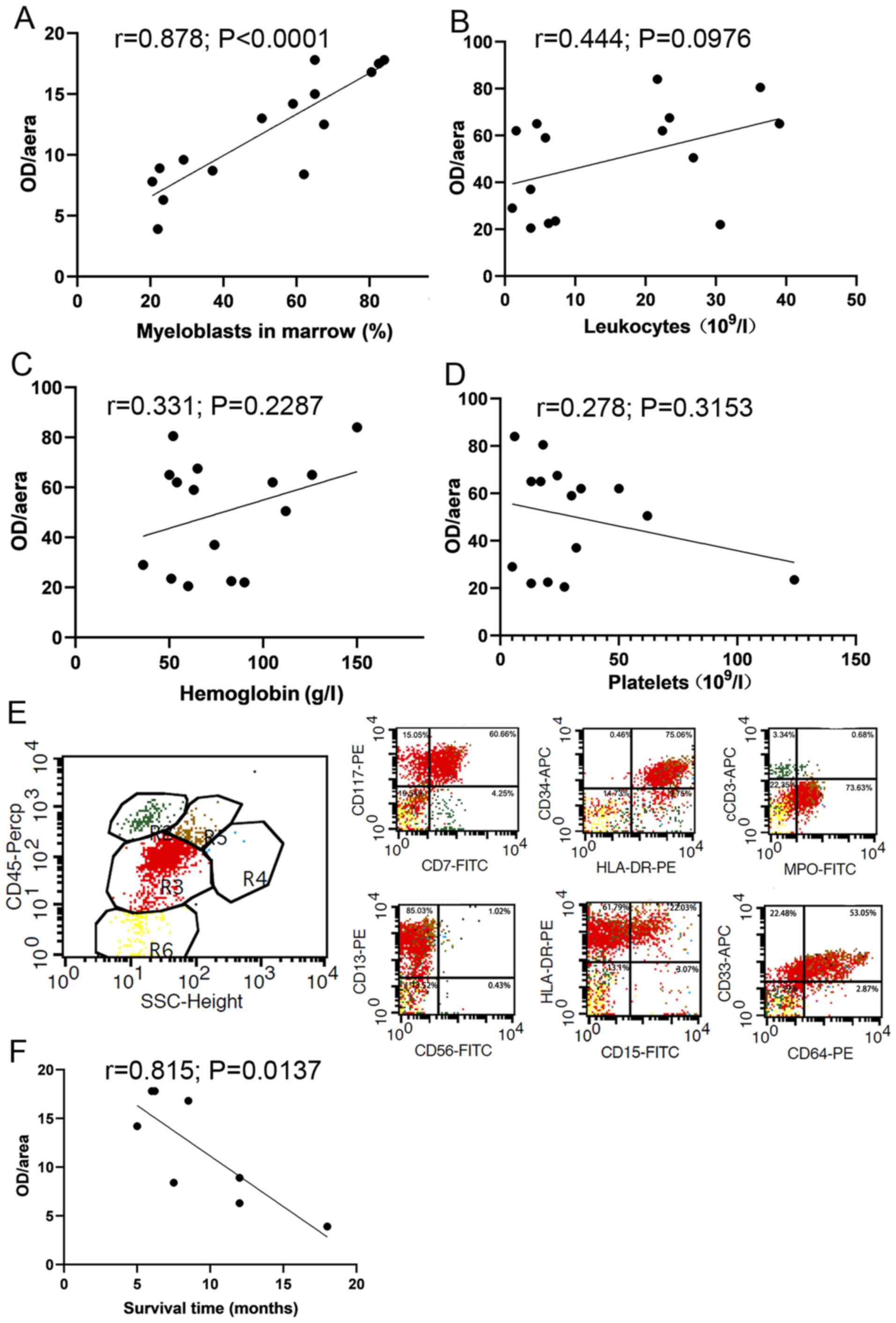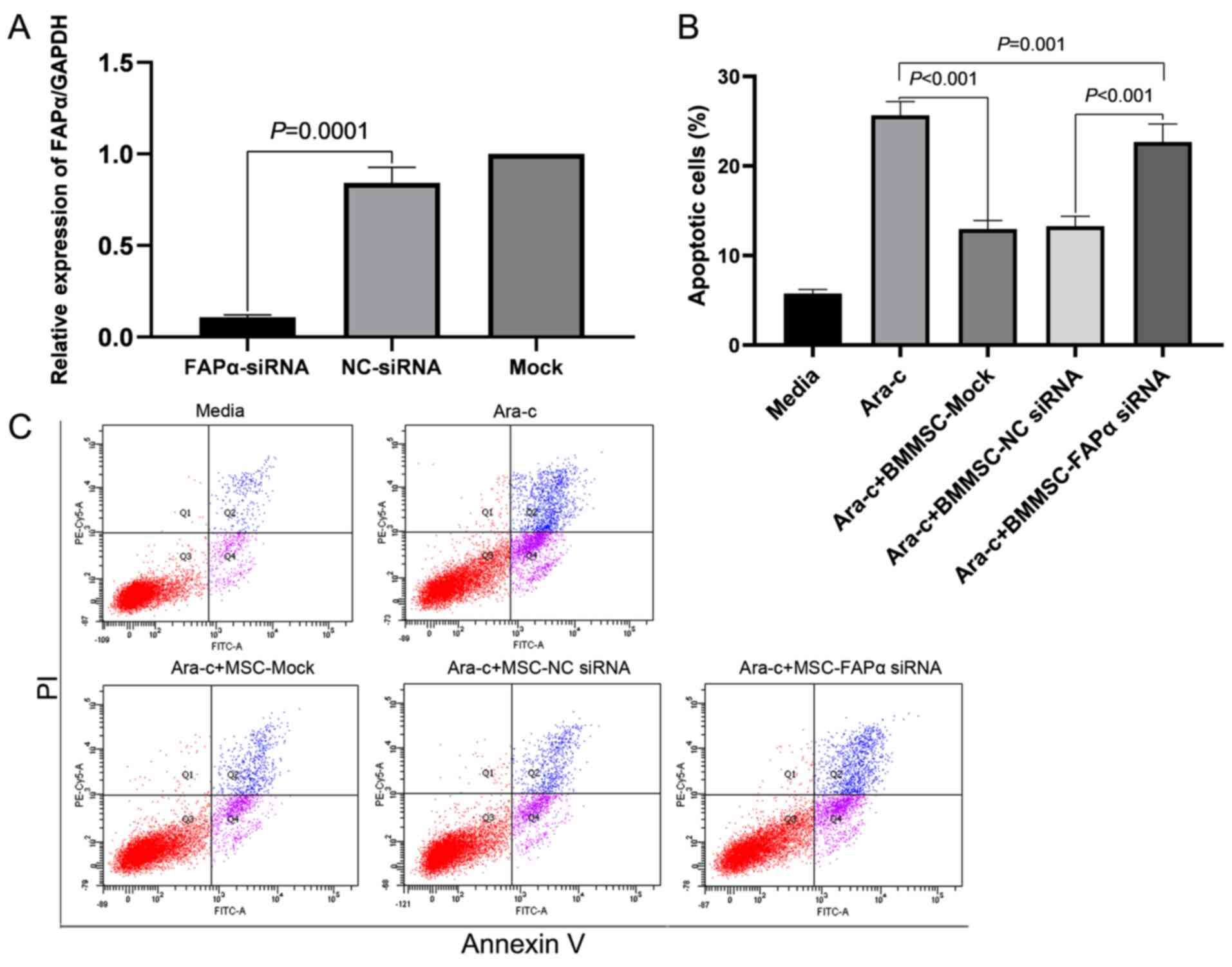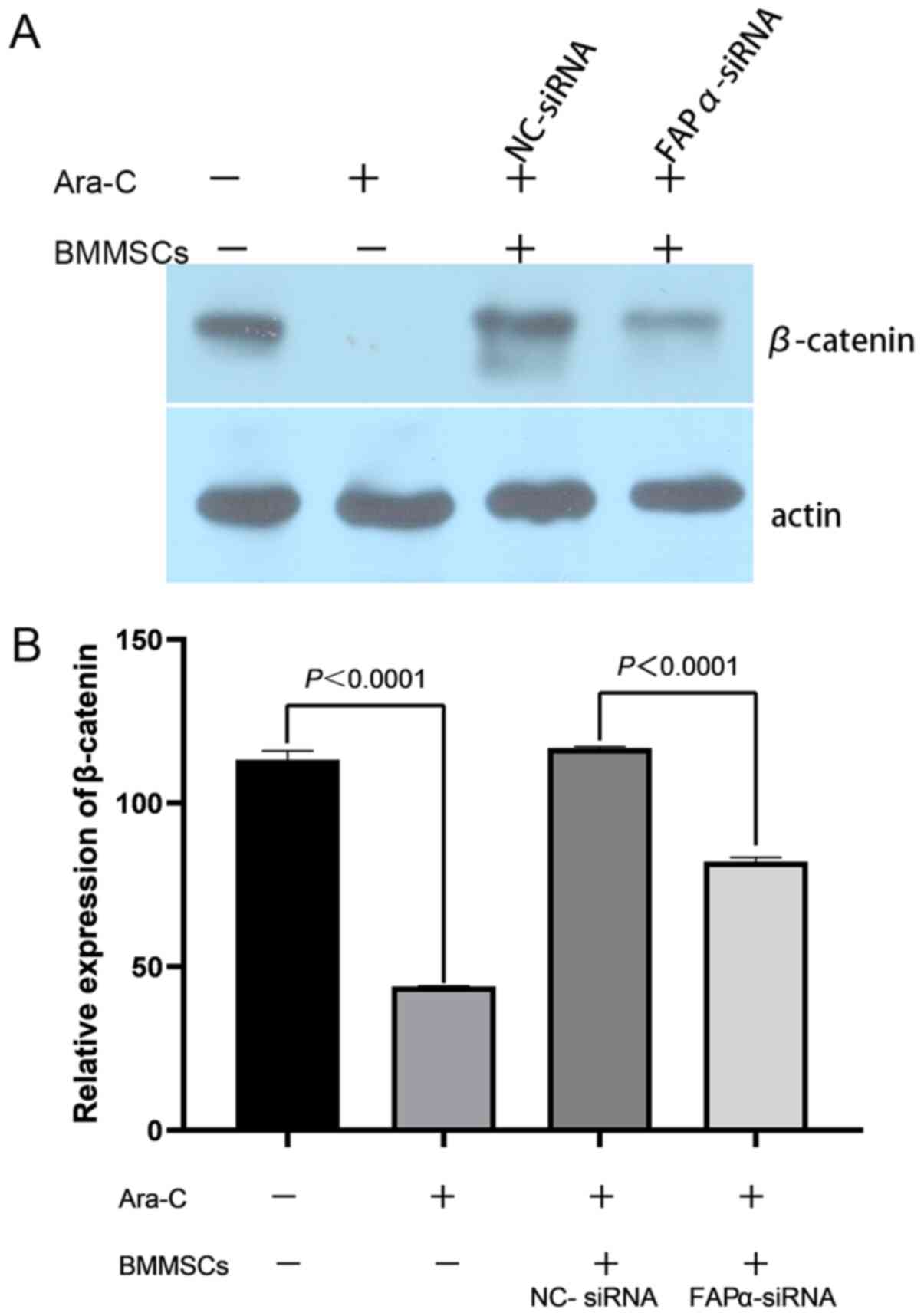|
1
|
Dores GM, Devesa SS, Curtis RE, Linet MS
and Morton LM: Acute leukemia incidence and patient survival among
children and adults in the United States, 2001-2007. Blood.
119:34–43. 2012. View Article : Google Scholar : PubMed/NCBI
|
|
2
|
Montesinos P, Bergua J, Infante J, Esteve
J, Guimaraes JE, Sierra J and Sanz MÁ: Update on management and
progress of novel therapeutics for R/R AML: An Iberian expert panel
consensus. Ann Hematol. 98:2467–2483. 2019. View Article : Google Scholar : PubMed/NCBI
|
|
3
|
Liao Z, Tan ZW, Zhu P and Tan NS:
Cancer-associated fibroblasts in tumor microenvironment -
Accomplices in tumor malignancy. Cell Immunol. 343:1037292019.
View Article : Google Scholar : PubMed/NCBI
|
|
4
|
Shafat MS, Gnaneswaran B, Bowles KM and
Rushworth SA: The bone marrow microenvironment - Home of the
leukemic blasts. Blood Rev. 31:277–286. 2017. View Article : Google Scholar : PubMed/NCBI
|
|
5
|
Geyh S, Rodríguez-Paredes M, Jäger P,
Khandanpour C, Cadeddu RP, Gutekunst J, Wilk CM, Fenk R, Zilkens C,
Hermsen D, et al: Functional inhibition of mesenchymal stromal
cells in acute myeloid leukemia. Leukemia. 30:683–691. 2016.
View Article : Google Scholar : PubMed/NCBI
|
|
6
|
von der Heide EK, Neumann M, Vosberg S,
James AR, Schroeder MP, Ortiz-Tanchez J, Isaakidis K, Schlee C,
Luther M, Jöhrens K, et al: Molecular alterations in bone marrow
mesenchymal stromal cells derived from acute myeloid leukemia
patients. Leukemia. 31:1069–1078. 2017. View Article : Google Scholar : PubMed/NCBI
|
|
7
|
Augsten M: Cancer-associated fibroblasts
as another polarized cell type of the tumor microenvironment. Front
Oncol. 4:622014. View Article : Google Scholar : PubMed/NCBI
|
|
8
|
Chaturvedi P, Gilkes DM, Wong CC, Luo W,
Zhang H, Wei H, Takano N, Schito L, Levchenko A, Semenza GL and
Kshitiz: Hypoxia-inducible factor-dependent breast
cancer-mesenchymal stem cell bidirectional signaling promotes
metastasis. J Clin Invest. 123:189–205. 2013. View Article : Google Scholar : PubMed/NCBI
|
|
9
|
Raz Y, Cohen N, Shani O, Bell RE,
Novitskiy SV, Abramovitz L, Levy C, Milyavsky M, Leider-Trejo L,
Moses HL, et al: Bone marrow-derived fibroblasts are a functionally
distinct stromal cell population in breast cancer. J Exp Med.
215:3075–3093. 2018. View Article : Google Scholar : PubMed/NCBI
|
|
10
|
Tao L, Huang G, Song H, Chen Y and Chen L:
Cancer associated fibroblasts: An essential role in the tumor
microenvironment. Oncol Lett. 14:2611–2620. 2017. View Article : Google Scholar : PubMed/NCBI
|
|
11
|
Zhou P, Xiao N and Wang J, Wang Z, Zheng
S, Shan S and Wang J, Du J and Wang J: SMC1A recruits
tumor-associated-fibroblasts (TAFs) and promotes colorectal cancer
metastasis. Cancer Lett. 385:39–45. 2017. View Article : Google Scholar : PubMed/NCBI
|
|
12
|
Komohara Y and Takeya M: CAFs and TAMs:
Maestros of the tumour microenvironment. J Pathol. 241:313–315.
2017. View Article : Google Scholar : PubMed/NCBI
|
|
13
|
Chen X and Song E: Turning foes to
friends: Targeting cancer-associated fibroblasts. Nat Rev Drug
Discov. 18:99–115. 2019. View Article : Google Scholar : PubMed/NCBI
|
|
14
|
Kalluri R: The biology and function of
fibroblasts in cancer. Nat Rev Cancer. 16:582–598. 2016. View Article : Google Scholar : PubMed/NCBI
|
|
15
|
LeBleu VS and Kalluri R: A peek into
cancer-associated fibroblasts: origins, functions and translational
impact. Dis Model Mech. 11:dmm0294472018. View Article : Google Scholar : PubMed/NCBI
|
|
16
|
Higashino N, Koma YI, Hosono M, Takase N,
Okamoto M, Kodaira H, Nishio M, Shigeoka M, Kakeji Y and Yokozaki
H: Fibroblast activation protein-positive fibroblasts promote tumor
progression through secretion of CCL2 and interleukin-6 in
esophageal squamous cell carcinoma. Lab Invest. 99:777–792. 2019.
View Article : Google Scholar : PubMed/NCBI
|
|
17
|
Wen X, He X, Jiao F, Wang C, Sun Y, Ren X
and Li Q: Fibroblast activation protein-α-positive fibroblasts
promote gastric cancer progression and resistance to immune
checkpoint blockade. Oncol Res. 25:629–640. 2017. View Article : Google Scholar : PubMed/NCBI
|
|
18
|
Hu M, Qian C, Hu Z, Fei B and Zhou H:
Biomarkers in tumor Microenvironment? Upregulation of fibroblast
activation protein-α correlates with gastric cancer progression and
poor prognosis. OMICS. 21:38–44. 2017. View Article : Google Scholar : PubMed/NCBI
|
|
19
|
Byrling J, Sasor A, Nilsson J, Said
Hilmersson K, Andersson R and Andersson B: Expression of fibroblast
activation protein and the clinicopathological relevance in distal
cholangiocarcinoma. Scand J Gastroenterol. 55:82–89. 2020.
View Article : Google Scholar : PubMed/NCBI
|
|
20
|
Zhang L, Yang L, Xia ZW, Yang SC, Li WH,
Liu B, Yu ZQ, Gong PF, Yang YL, Sun WZ, et al: The role of
fibroblast activation protein in progression and development of
osteosarcoma cells. Clin Exp Med. 20:121–130. 2020. View Article : Google Scholar : PubMed/NCBI
|
|
21
|
Pleshkan VV, Alekseenko IV, Tyulkina DV,
Kyzmich AI, Zinovyeva MV and Sverdlov ED: Fibroblast activation
protein (FAP) as a possible target of an antitumor strategy. Mol
Gen Mikrobiol Virusol. 34:90–97. 2016. View Article : Google Scholar : PubMed/NCBI
|
|
22
|
Li M, Li M, Yin T, Shi H, Wen Y, Zhang B,
Chen M, Xu G, Ren K and Wei Y: Targeting of cancer associated
fibroblasts enhances the efficacy of cancer chemotherapy by
regulating the tumor microenvironment. Mol Med Rep. 13:2476–2484.
2016. View Article : Google Scholar : PubMed/NCBI
|
|
23
|
Raffaghello L, Vacca A, Pistoia V and
Ribatti D: Cancer associated fibroblasts in hematological
malignancies. Oncotarget. 6:2589–2603. 2015. View Article : Google Scholar : PubMed/NCBI
|
|
24
|
Zi FM, He JS, Li Y, Wu C, Wu WJ, Yang Y,
Wang LJ, He DH, Yang L, Zhao Y, et al: Fibroblast activation
protein protects bortezomib-induced apoptosis in multiple myeloma
cells through β-catenin signaling pathway. Cancer Biol Ther.
15:1413–1422. 2014. View Article : Google Scholar : PubMed/NCBI
|
|
25
|
Pittenger MF: Mesenchymal stem cells from
adult bone marrow. Mesenchymal Stem Cells. Springer; Basel: pp.
27–44. 2008, View Article : Google Scholar
|
|
26
|
Arber DA, Orazi A, Hasserjian R, Thiele J,
Borowitz MJ, Le Beau MM, Bloomfield CD, Cazzola M and Vardiman JW:
The 2016 revision to the World Health Organization classification
of myeloid neoplasms and acute leukemia. Blood. 127:2391–2405.
2016. View Article : Google Scholar : PubMed/NCBI
|
|
27
|
Livak KJ and Schmittgen TD: Analysis of
relative gene expression data using real-time quantitative PCR and
the 2(-Delta Delta C(T)) method. Methods. 25:402–408. 2001.
View Article : Google Scholar : PubMed/NCBI
|
|
28
|
Yang Y, Mallampati S, Sun B, Zhang J, Kim
SB, Lee JS, Gong Y, Cai Z and Sun X: Wnt pathway contributes to the
protection by bone marrow stromal cells of acute lymphoblastic
leukemia cells and is a potential therapeutic target. Cancer Lett.
333:9–17. 2013. View Article : Google Scholar : PubMed/NCBI
|
|
29
|
Abramoff MD, Magalhaes PJ and Ram SJ:
Image processing with ImageJ. Biophoton Int. 11:36–42. 2004.
|
|
30
|
Caplan AI: Mesenchymal stem cells. J
Orthop Res. 9:641–650. 1991. View Article : Google Scholar : PubMed/NCBI
|
|
31
|
Dominici M, Le Blanc K, Mueller I,
Slaper-Cortenbach I, Marini F, Krause D, Deans R, Keating A,
Prockop Dj and Horwitz E: Minimal criteria for defining multipotent
mesenchymal stromal cells. The International Society for Cellular
Therapy position statement. Cytotherapy. 8:315–317. 2006.
View Article : Google Scholar : PubMed/NCBI
|
|
32
|
Rettig WJ, Chesa PG, Beresford HR,
Feickert HJ, Jennings MT, Cohen J, Oettgen HF and Old LJ:
Differential expression of cell surface antigens and glial
fibrillary acidic protein in human astrocytoma subsets. Cancer Res.
46:6406–6412. 1986.PubMed/NCBI
|
|
33
|
Rettig WJ, Su SL, Fortunato SR, Scanlan
MJ, Raj BK, Garin-Chesa P, Healey JH and Old LJ: Fibroblast
activation protein: Purification, epitope mapping and induction by
growth factors. Int J Cancer. 58:385–392. 1994. View Article : Google Scholar : PubMed/NCBI
|
|
34
|
Scanlan MJ, Raj BK, Calvo B, Garin-Chesa
P, Sanz-Moncasi MP, Healey JH, Old LJ and Rettig WJ: Molecular
cloning of fibroblast activation protein alpha, a member of the
serine protease family selectively expressed in stromal fibroblasts
of epithelial cancers. Proc Natl Acad Sci USA. 91:5657–5661. 1994.
View Article : Google Scholar : PubMed/NCBI
|
|
35
|
Rettig WJ, Garin-Chesa P, Healey JH, Su
SL, Ozer HL, Schwab M, Albino AP and Old LJ: Regulation and
heteromeric structure of the fibroblast activation protein in
normal and transformed cells of mesenchymal and neuroectodermal
origin. Cancer Res. 53:3327–3335. 1993.PubMed/NCBI
|
|
36
|
Keane FM, Yao TW, Seelk S, Gall MG,
Chowdhury S, Poplawski SE, Lai JH, Li Y, Wu W, Farrell P, et al:
Quantitation of fibroblast activation protein (FAP)-specific
protease activity in mouse, baboon and human fluids and organs.
FEBS Open Bio. 4:43–54. 2013. View Article : Google Scholar : PubMed/NCBI
|
|
37
|
Jacob M, Chang L and Puré E: Fibroblast
activation protein in remodeling tissues. Curr Mol Med.
12:1220–1243. 2012. View Article : Google Scholar : PubMed/NCBI
|
|
38
|
Chung KM, Hsu SC, Chu YR, Lin MY, Jiaang
WT, Chen RH and Chen X: Fibroblast activation protein (FAP) is
essential for the migration of bone marrow mesenchymal stem cells
through RhoA activation. PLoS One. 9:e887722014. View Article : Google Scholar : PubMed/NCBI
|
|
39
|
Hamson EJ, Keane FM, Tholen S, Schilling O
and Gorrell MD: Understanding fibroblast activation protein (FAP):
Substrates, activities, expression and targeting for cancer
therapy. Proteomics Clin Appl. 8:454–463. 2014. View Article : Google Scholar : PubMed/NCBI
|
|
40
|
Zi F, He J, He D, Li Y, Yang L and Cai Z:
Fibroblast activation protein α in tumor microenvironment: Recent
progression and implications (Review). Mol Med Rep. 11:3203–3211.
2015. View Article : Google Scholar : PubMed/NCBI
|
|
41
|
Tian K, Yang S, Ren Q and Han Z, Lu S, Ma
F, Zhang L and Han Z: p38 MAPK contributes to the growth inhibition
of leukemic tumor cells mediated by human umbilical cord
mesenchymal stem cells. Cell Physiol Biochem. 26:799–808. 2010.
View Article : Google Scholar : PubMed/NCBI
|
|
42
|
Liu F, Qi L, Liu B, Liu J, Zhang H, Che D,
Cao J, Shen J, Geng J, Bi Y, et al: Fibroblast activation protein
overexpression and clinical implications in solid tumors: A
meta-analysis. PLoS One. 10:e01166832015. View Article : Google Scholar : PubMed/NCBI
|
|
43
|
Traer E, Martinez J, Javidi-Sharifi N,
Agarwal A, Dunlap J, English I, Kovacsovics T, Tyner JW, Wong M and
Druker BJ: FGF2 from marrow microenvironment promotes resistance to
FLT3 inhibitors in acute myeloid leukemia. Cancer Res.
76:6471–6482. 2016. View Article : Google Scholar : PubMed/NCBI
|
|
44
|
Fathi E, Sanaat Z and Farahzadi R:
Mesenchymal stem cells in acute myeloid leukemia: A focus on
mechanisms involved and therapeutic concepts. Blood Res.
54:165–174. 2019. View Article : Google Scholar : PubMed/NCBI
|
|
45
|
Brenner AK, Nepstad I and Bruserud Ø:
Mesenchymal stem cells support survival and proliferation of
primary human acute myeloid leukemia cells through heterogeneous
molecular mechanisms. Front Immunol. 8:1062017. View Article : Google Scholar : PubMed/NCBI
|
|
46
|
Li Q, Pang Y, Liu T, Tang Y, Xie J, Zhang
B and Chen H: Effects of human umbilical cord-derived mesenchymal
stem cells on hematologic malignancies. Oncol Lett. 15:6982–6990.
2018.PubMed/NCBI
|
|
47
|
Yang X, Sexauer A and Levis M: Bone marrow
stroma-mediated resistance to FLT3 inhibitors in FLT3-ITD AML is
mediated by persistent activation of extracellular regulated
kinase. Br J Haematol. 164:61–72. 2014. View Article : Google Scholar : PubMed/NCBI
|
|
48
|
Tian C, Zheng G, Zhuang H, Li X, Hu D, Zhu
L, Wang T, You MJ and Zhang Y: MicroRNA-494 activation suppresses
bone marrow stromal cell-mediated drug resistance in acute myeloid
leukemia cells. J Cell Physiol. 232:1387–1395. 2017. View Article : Google Scholar : PubMed/NCBI
|
|
49
|
Guo F, Wang Y, Liu J, Mok SC, Xue F and
Zhang W: CXCL12/CXCR4: A symbiotic bridge linking cancer cells and
their stromal neighbors in oncogenic communication networks.
Oncogene. 35:816–826. 2016. View Article : Google Scholar : PubMed/NCBI
|
|
50
|
Malfuson JV, Boutin L, Clay D, Thépenier
C, Desterke C, Torossian F, Guerton B, Anginot A, de Revel T,
Lataillade JJ, et al: SP/drug efflux functionality of hematopoietic
progenitors is controlled by mesenchymal niche through VLA-4/CD44
axis. Leukemia. 28:853–864. 2014. View Article : Google Scholar : PubMed/NCBI
|
|
51
|
Battula VL, Benito J, Somanchi AG, Duvvuri
S, Hodgson L, Chen Y, Ma W, Davis RE, McNiece I, Shpall EJ, et al:
Acute myeloid leukemia cells acquire stem cell features in the bone
marrow microenvironment. Clin Lymphoma Myeloma Leuk. 14:S119–S120.
2014. View Article : Google Scholar
|
|
52
|
Nusse R and Clevers H: Wnt/β-catenin
signaling, disease, and emerging therapeutic modalities. Cell.
169:985–999. 2017. View Article : Google Scholar : PubMed/NCBI
|
|
53
|
Wang Y, Krivtsov AV, Sinha AU, North TE,
Goessling W, Feng Z, Zon LI and Armstrong SA: The Wnt/beta-catenin
pathway is required for the development of leukemia stem cells in
AML. Science. 327:1650–1653. 2010. View Article : Google Scholar : PubMed/NCBI
|















